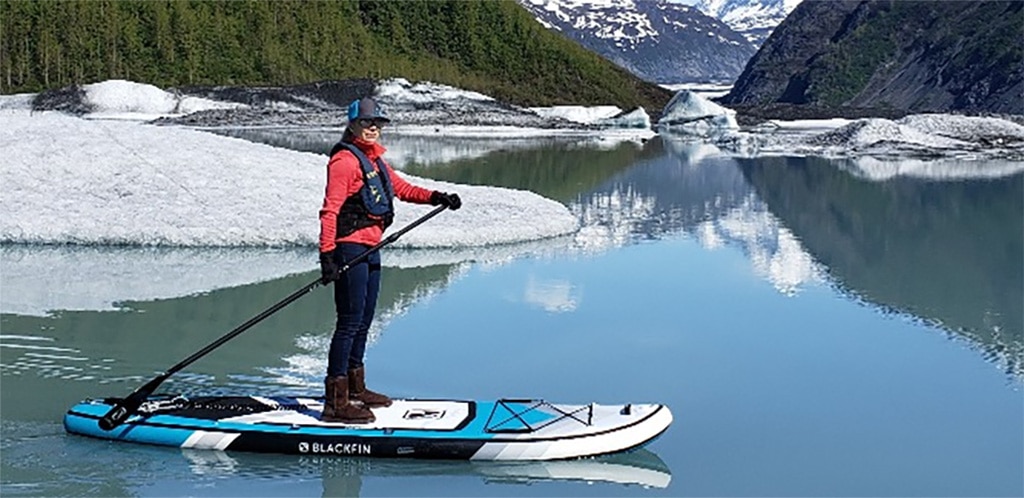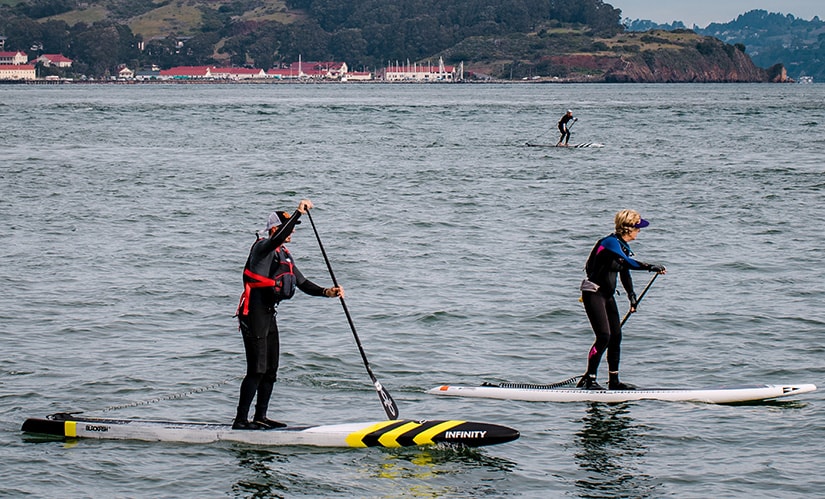Unlike other life jackets or life vests, inflatable life jackets have several components to them that are crucial to safety and performance. It’s important to check these components regularly in order for your inflatable PFD to operate as intended.
You should check the inflator on a type V inflatable PFD every time you use it, and be sure to do a more thorough inspection of your inflator every two months.
Let’s go over how you should inspect your life jacket both for immediate use and after you have pulled it out of storage.
RELATED: Discover the best PFD for SUP boarding of 2024
Key Takeaways
- You should check the inflator on a type V inflatable PFD every time you use it.
- Check the exterior of the life jacket for any visible tears, rips, or other signs of weakness or damage.
- Inspect the CO2 cylinder to see if there’s a puncture, dust, or rust.
- If you are pulling your inflatable life jacket out of long-term storage, do the overnight inflation test. Inflate your life jacket and then leave it inflated overnight to see if it leaks.
- Conduct a thorough inspection every two months to ensure all components are in good working order.
Inspecting the Exterior
As stated, you should inspect the exterior of your life jacket or personal floatation device every time you intend to use it. Check the exterior of the life jacket for any visible tears, rips, or other signs of weakness or damage.
Also inspect the buckles and ensure they are in good working order. If the exterior looks good, you can unpack or unroll your life jacket to inspect it further. As you unroll it, look for tears, rips, or other issues that may impact your life jacket’s performance.
Overnight Inflation Test
If you are pulling your inflatable life jacket out of storage or have questions about it’s integrity, you can put it through the overnight inflation test.
To do this, simply inflate your life jacket and then leave it inflated overnight. The next morning, check to see whether or not your life jacket has leaked any air. If it is still inflated, you can deflate, roll it back up, and use it with confidence.
Regular Detailed Inspections
You should do a detailed inspection of your inflatable PFD everytime you intend to use it. The inspection should consist of examining the automatic inflation indicator to make sure it is ready to be used.
If you are pulling your inflatable life jacket out of storage, you will need to do a more thorough inspection. The thorough inspection should consist of examining the CO2 canister, the bobbin, and the screw on cover. You should also conduct a thorough inspection every two months to ensure all components are in good working order.
Inspect the CO2 Cylinder
Unscrew and inspect your CO2 cylinder. It shouldn’t have an opening (or puncture) on the tip as this will impact whether it will inflate when needed. Ensure that the cylinder is also free of any rust, dust, or corrosion that might keep it from inflating. If there is corrosion or rust, you may need to replace the CO2 canister.
The cover that the CO2 canister screws into will include a dissolvable pill or bobbin. Ensure that the bobbin is intact and free of any cracks, and that the white material within it doesn’t show any signs of crumbling.
Next, you’ll want to inspect the automatic service indicator. This indicator will either be a green or red strip (or tab).
A green tab indicates that your life jacket is ready to go and will automatically inflate when it comes in contact with the water. If you see red instead of green, this means that your life jacket won’t automatically inflate. Instead, you will need to use a rearming kit to begin the recharging process to return the inflator back to a green status.
Your life jacket will still inflate even if the indicator is red. However you can only inflate it manually, not automatically.
Inspect Safety Harness, Straps, and Buckles
Your safety harnesses, straps, and buckles are just as important as the inflator mechanism that inflates your personal floatation device.
Inspect these different components to make sure they are free of any rips or tears. Buckle and unbuckle the strap and ensure that it fastens properly.
Follow Your PFD Care Instructions
Because there are different types of inflatable PFDs, one model may not operate in the same manner another model will. Because of this, it’s important to read and understand your manufacturer’s instructions.
Some models may require more frequent maintenance or may have an inflation mechanism that operates or looks differently than what you are used to. It’s important to familiarize yourself with your model before you use it so that you know what to expect out of it.
ALSO READ: How do you clean a life jacket?
Understanding a Type V Life Jacket
Inflatable wearable life jackets fall under the classification of Type II, Type III, and Type V life jackets. While inflatable PFDs are known for their comfort, they do lack some safety features that can help in emergency situations.
Unlike inherently buoyant life jackets, inflatable PFDs were not designed for rough or isolated waters or for extended survival. Instead, Inflatable PFDs were designed for use on relaxed outings like paddleboarding, waterskiing, kayaking, and other similar activities on personal watercraft and other recreational vessels.
Inflatable PFDs, including pouch style inflation models, can also fall under the Type V catorgory. This class of life jackets is referred to as “specialty use jackets.” Many inflatables will often be categorized for use in specific activities like the ones listed above. Specialty use jackets may have their own maintenance requirements as well.
It’s important to keep in mind that many inflatable PFDs cannot turn an unconscious wearer face up. Because of this, an inflatable PFD may not be the right safety equipment to use if you need an offshore life jacket that will automatically put you in a face up position.
Simplify Maintenance With Inherently Buoyant Life Jackets
If you are new to boating safety, it can be overwhelming to understand the maintenance required of an inflatable personal flotation device.
To keep things simple, it might be more fitting for you to opt for an inherently buoyant life jacket or vest instead. A Coast Guard approved life jacket can be just as effective if not safer than an inflatable life jacket.
For example, Type I and Type II buoyant PFDs and life jackets are ideal for boating safety because they can turn unconscious when in the face up position. Plus, they work well in rough water conditions too.
Not only that, but they are much easier to maintain and keep in good working order. Inherently buoyant PFDs require less detailed and regular maintenance and are free of any components like an inflation mechanism.
YOU MAY ALSO LIKE: What are the paddle board life jacket requirements in the USA?
Conclusion
It’s vitally important that you understand the inner workings of your inflatable personal flotation device in order for it to perform as needed. Don’t forget to go over the manufacturer recommendations for maintenance and upkeep as well.
Do you have a favorite inflatable flotation device that has served you well? Be sure to share with us the model in the comments section below.



